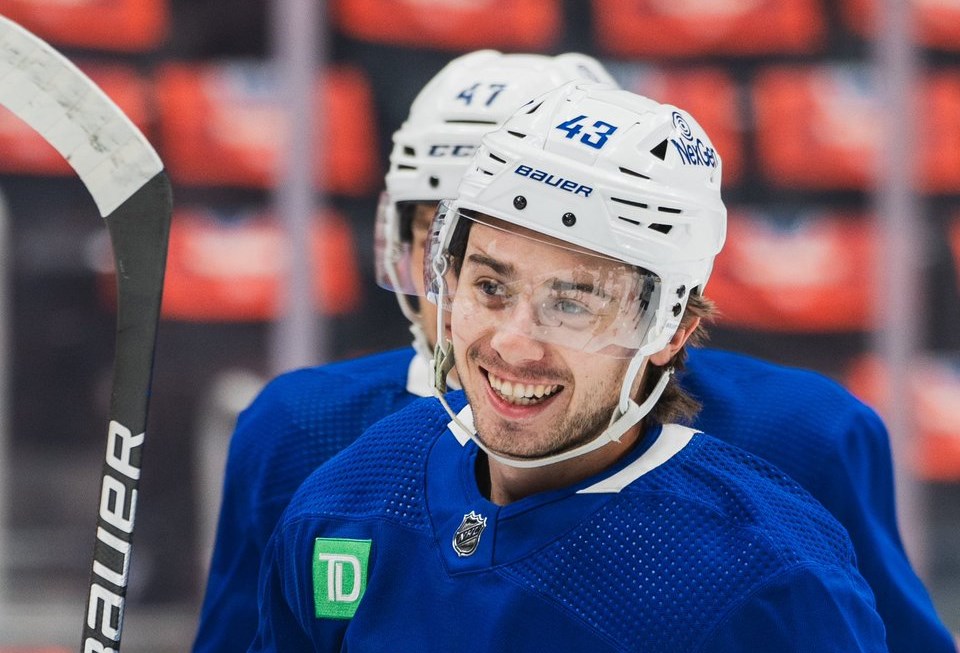With just a handful of games remaining in the regular season, Quinn Hughes still holds the lead for most points by a defenceman this season.
With 86 points in 76 games, Hughes is four points up on second-place Cale Makar and is on pace for 93 points, which would make him just the third defenceman in the last thirty years to crack 90 points.
Unsurprisingly, Hughes’ prolific season has given him the best odds of winning the Norris Trophy as the NHL’s best defenceman. But he’s not alone in the race.
Is the Norris a two-horse race between Hughes and Makar?
Roman Josi has made a charge as he’s led the Nashville Predators on a phenomenal late-season run. Evan Bouchard has been outstanding for the Edmonton Oilers. Over in the Eastern Conference, Noah Dobson has earned some buzz for keeping his New York Islanders in contention.
But many contend that the Norris will come down to just two players: Hughes and Makar.
“With all due respect to Roman Josi, I think this is a two-horse race,” said PHWA president Frank Seravalli on the Skeres and Price show on Friday. “I honestly think with both of these players, we’re splitting the thinnest of hairs…My guess is this is going to be one of the closest Norris Trophy votes, in terms of points, that we’ve ever seen.”
With all due respect to Seravalli, this has no business being a two-horse race. It really shouldn’t be. If it is a two-horse race between Hughes and Makar, then Hughes has already crossed the finish line, received his laurels, and is back in the paddock relaxing while Makar is still galloping down the home stretch.
Okay, maybe that’s exaggerating but there’s really only one argument that can be made in favour of Makar over Hughes: he has about the same number of points as Hughes but has three more goals. In fact, that’s the exact argument made by a voter in ESPN’s Awards Watch.
“Makar and Hughes are neck and neck,” said the anonymous voter. “I give the nod to Makar on the strength of his 19 goals.”
It’s a stunningly superficial argument that flatly ignores every other aspect of the game.
Hughes has been better than Makar by almost any metric
Let’s be clear: Cale Makar is an amazing defenceman who well deserved the Norris he won in 2022. But this season, Hughes has clearly been better and deserves to win the 2024 Norris.
We can show this in a few different ways, but let’s start with a statistic that boils a player's season down to a single number: Evolving-Hockey’s Goals Above Replacement (GAR), which aims to measure how much better a player is than a replacement-level player who could be called up from the AHL.
Quinn Hughes leads all defencemen with 23.3 GAR, ahead of Evan Bouchard at 20.9 and Roman Josi at 19.9. Cale Makar is in eighth, with a 15.3 GAR, well behind the three leaders.
But that’s pretty abstract. Maybe you’re not a big fan of analytical models and prefer something a little more concrete. Well, how’s this: With Quinn Hughes on the ice at 5-on-5, the Canucks have out-scored their opponents by 36 goals. Without Hughes, they’ve still out-scored their opponents but only by 15 goals.
Compare that to Makar: with Makar, the Avalanche have out-scored their opponents by only 7 goals at 5-on-5. Without him, that shoots up to plus-22. The Avalanche have arguably been better at 5-on-5 without Makar.
The other competitors for the Norris have the same kind of goal differential swing as Hughes, with Evan Bouchard and Noah Dobson boasting the biggest swing at 30 goals. Makar is the outlier.
Hughes has been better than Makar defensively
The difference between Makar and his fellow Norris candidates is primarily because of defence.
There’s an assumption from those who haven’t watched Hughes play very much that he’s bad defensively. It’s an assumption likely borne of his small size. The truth is, Hughes has been excellent defensively all season for the Canucks. In fact, he’s been on the ice for the lowest rate of shot attempts against for the Canucks by a wide margin.
That holds up league-wide: among the 120 NHL defencemen who have played at least 1000 5-on-5 minutes this season, Quinn Hughes has the fourth-lowest rate of shot attempts against when he’s on the ice. Makar is 56th.
Of the five candidates we’re looking at for the Norris Trophy, Makar has been on the ice for the highest rate of goals against at 5-on-5; Hughes has been on the ice for the lowest.
To be fair, Hughes has had the benefit of playing in front of Thatcher Demko, which makes a difference. But even when it comes to underlying analytics like corsi (CF%) and expected goals (xGF%), Hughes has the edge on Makar.
And when it comes to those analytics, it’s important to keep in mind context, such as who each of these defencemen is playing with.
Makar benefits massively from playing with MacKinnon
Makar has played the vast majority of his minutes with the favourite for the Hart Trophy, Nathan MacKinnon. When Makar has been on the ice without MacKinnon, the difference has been stark.
With MacKinnon, Makar has a 55.97% corsi; without MacKinnon, Makar drops to a 46.31% corsi — the Avalanche get significantly out-shot in those situations.
Makar is also the only defenceman among these Norris candidates whose star forward actually has a better corsi without him. Once again, the Avalanche have arguably been better off this season when Makar has been on the bench.
Compare that to how J.T. Miller and Elias Pettersson perform with and without Hughes. With Hughes, Miller and Pettersson crush puck possession with 55.87% and 57.08% corsi percentages. Without him, they drop precipitously to 45.85% and 48.42%.
Hughes, on the other hand, is just as dominant without Miller or Pettersson as he is with them. Pick a centre and Hughes has dominated with them. Teddy Blueger has a 59.73% corsi with Hughes. Pius Suter has a 57.68% corsi with Hughes. Nils Åman? 55.88% corsi with Hughes.
Literally every single Canucks forward who has spent at least 50 minutes with Hughes at 5-on-5 this season has a corsi percentage above 50% — most of them, well above 50%. The same simply cannot be said for Makar.
In other words, Hughes is a game-changer for the Canucks no matter who he plays with, while Makar has been heavily dependent this season on playing with MacKinnon.
Hughes has been better than Makar on the penalty kill
There is one other statistic where Makar beats Hughes: shorthanded time on ice.
Makar has averaged 2:36 per game on the penalty kill, which is far more than his fellow Norris candidates. Dobson is next highest at 1:08 per game, then Hughes at 0:38, Josi at 0:31, and Bouchard at 0:21.
That could sway some voters.
“Call me a traditionalist, but I still like to award defensemen that actually, you know, defend as a big part of their job,” said one anonymous voter to ESPN in arguing that Makar’s time on the penalty kill should be a major factor.
Here’s the thing: Makar has certainly played more on the penalty kill than Hughes but has he actually played better on the penalty kill?
Hughes has been on the ice for 69.5 unblocked shot attempts against and 5.15 goals against per 60 minutes on the penalty kill this season. Hughes is ranked second among Canucks defencemen in both those statistics.
Makar has been on the ice for 83.2 unblocked shot attempts against and 7.10 goals against per 60 minutes on the penalty kill this season. Both of those statistics rank dead last among Avalanche defencemen.
Among the 185 defencemen who have spent at least 30 minutes on the penalty kill this season, Hughes ranks 52nd in unblocked shot attempts against and 32nd in goals against. Makar ranks 139th and 93rd.
In other words, while Makar has played more on the penalty kill, he’s been rather bad at doing the actual job. By Evolving-Hockey’s GAR metric, Hughes has been a modest boon on the penalty kill, adding 0.4 goals above a replacement-level defender; Makar has been a detriment at -2.3 goals, suggesting the Avalanche would be better off limiting Makar’s minutes in the penalty kill and giving them to almost anyone else.
So, as the anonymous voter said to ESPN, if the goal is to reward the defenceman who actually defends as part of their job, then the Norris should definitely go to Hughes, who has been better than Makar defensively at both 5-on-5 and on the penalty kill.
Really, the defencemen who ought to be challenging Hughes for the Norris are Bouchard and Josi, who have had a more distinct impact for their teams this season than Makar. But if the penalty kill matters so much, perhaps that’s a disqualifying factor for both of them, as Bouchard hasn’t even played 30 shorthanded minutes this season, while Josi has been on the ice for a whopping 16.78 goals against per 60 minutes on the penalty kill.
Hughes has been better than everyone at everything
To finish off, let’s look at a few more charts from Evolving-Hockey that compare how players have performed in a few different statistics per 60 minutes at 5-on-5: goals for, expected goals for, corsi for, expected goals against, and corsi against.
Here’s Hughes vs Dobson:
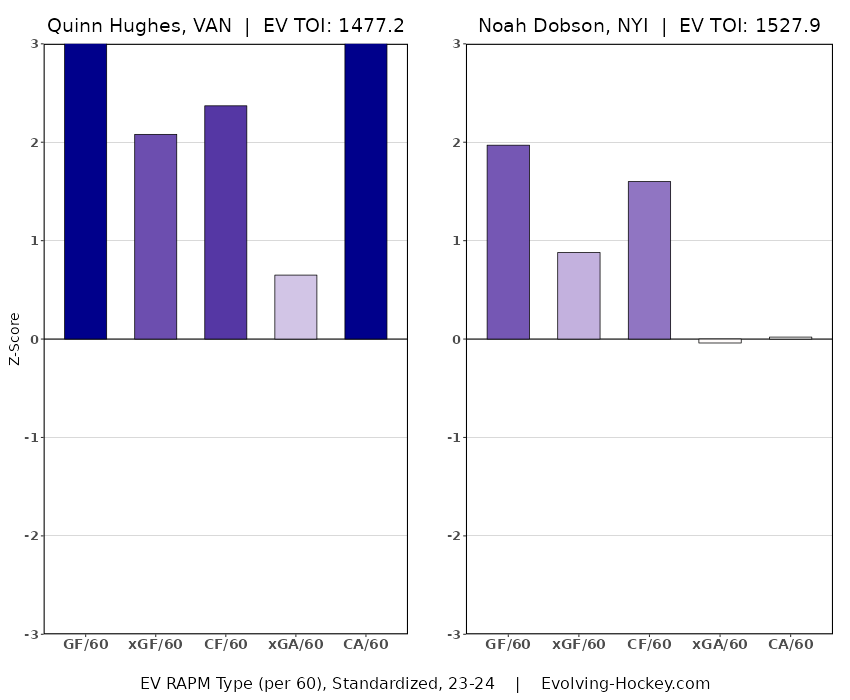
Here’s Hughes vs Bouchard:
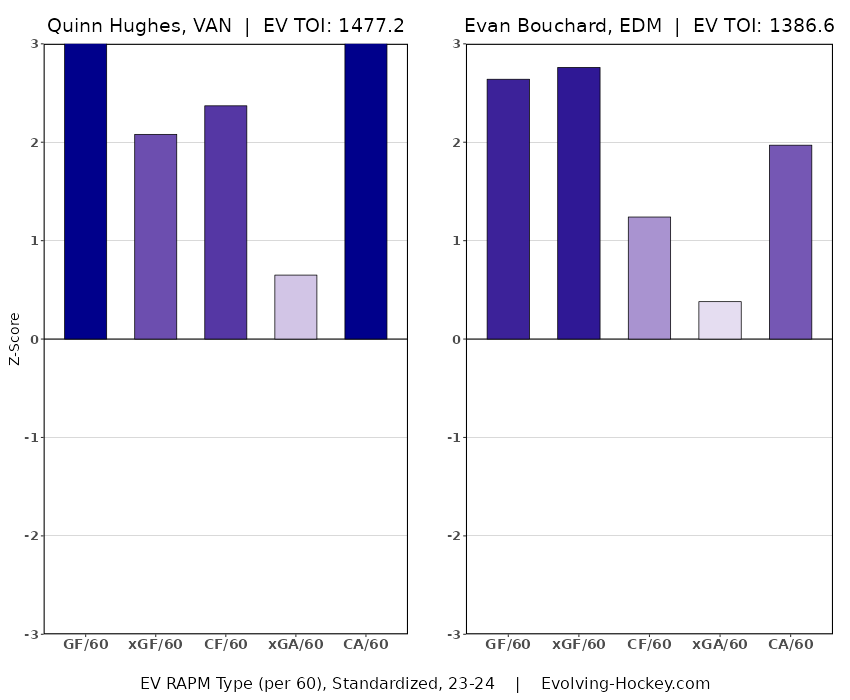
Here’s Hughes vs Josi:
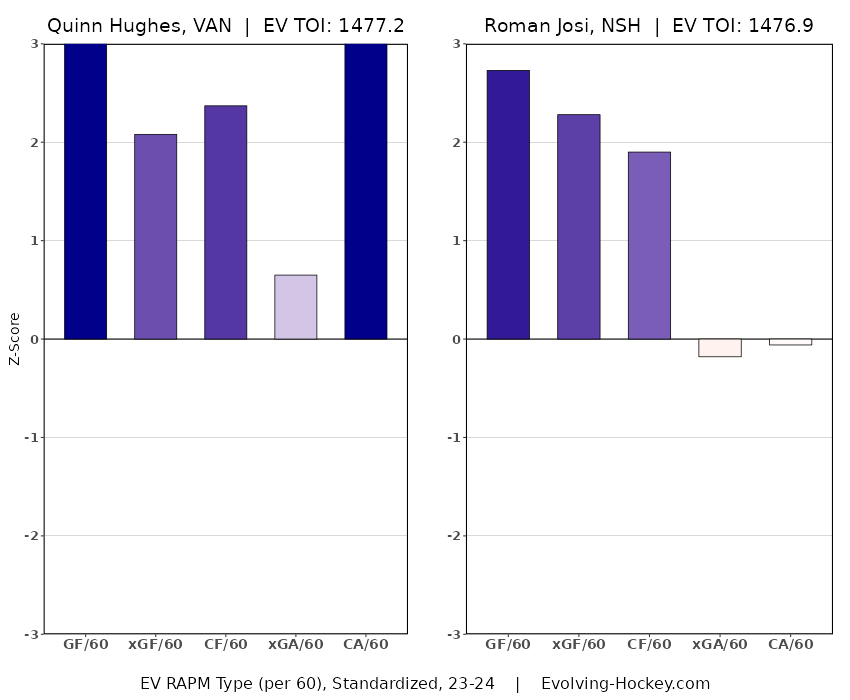
All three of those defencemen look pretty good in these charts, particularly Bouchard and Josi. But none of them break the chart like Hughes does, with absolutely dominant puck possession numbers for both corsi for and corsi against. It should be clear: Hughes has been not only better offensively than his peers but also better defensively.
And here’s Hughes vs Makar:
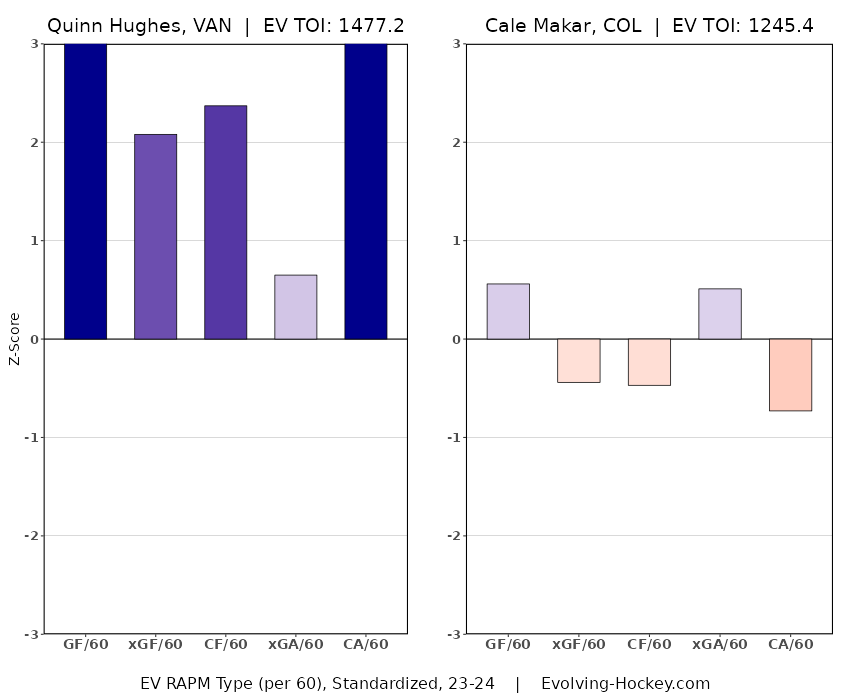
There’s no contest.
